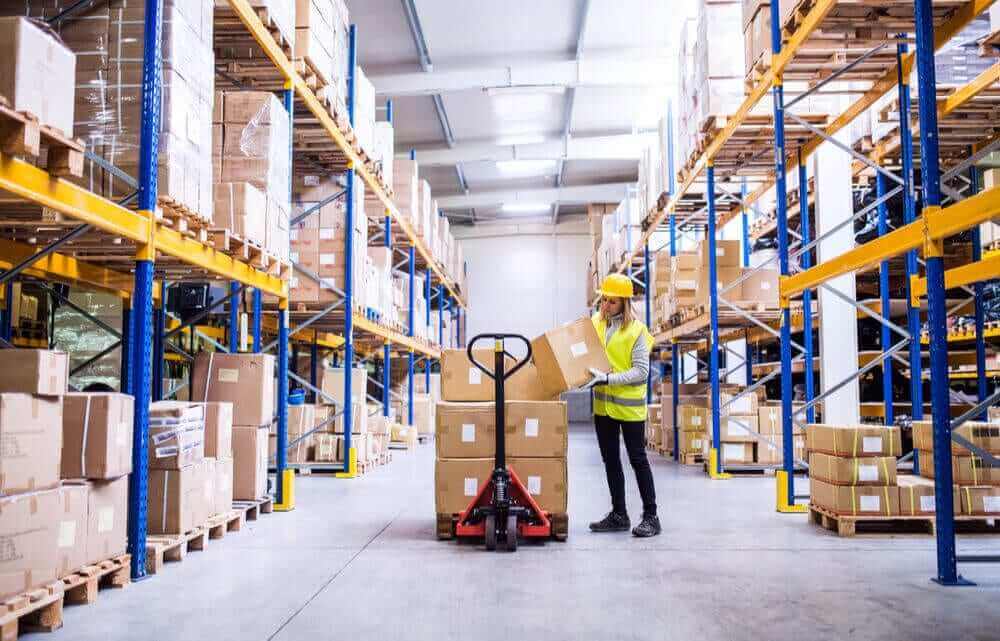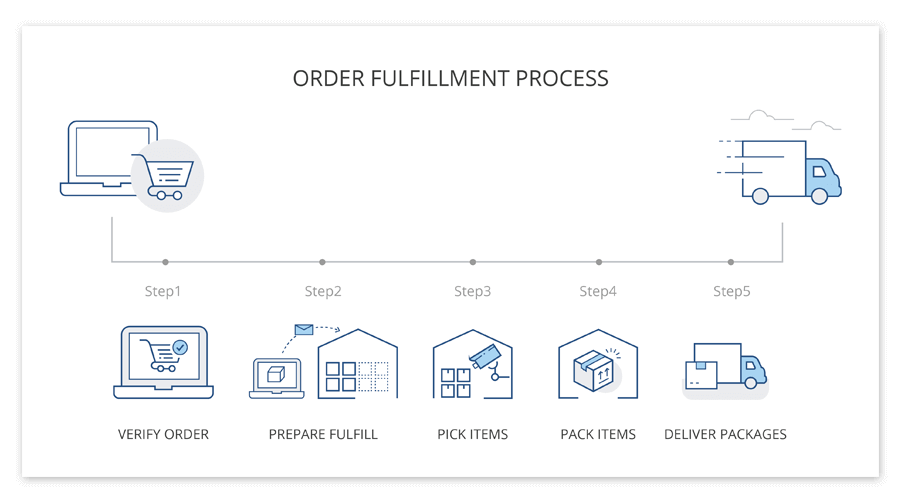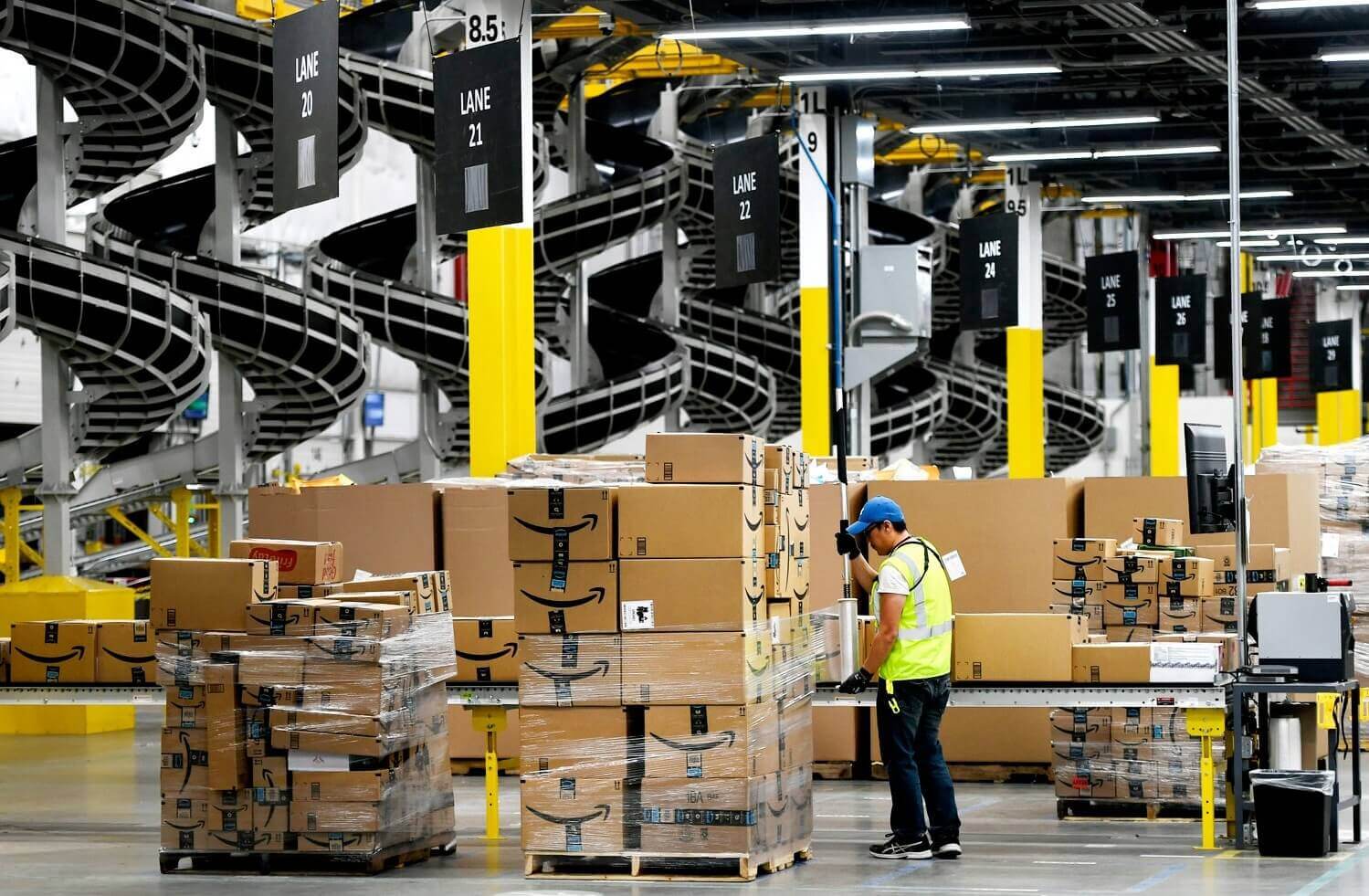A fulfillment center is a location where third-party logistics providers fulfill eCommerce orders. A fulfillment center can take online orders in real-time and simplify fulfillment processes for eCommerce retailers. Some people use the terms warehouses and fulfillment centers interchangeably. Essentially, both are large buildings that can hold inventory for all types of physical sales, such as online stores or brick-and-mortar retailers. A warehouse is a place to store inventory, while a fulfillment warehouse does more than just store it. This article will define “What is a fulfillment center?” and differentiate warehouse and fulfillment services, so you’ll have a better idea of the right eCommerce shipping solution for your retail business.
What is a fulfillment center?

Fulfillment centers or third-party logistics (3PL) provide fulfillment services to ensure orders are to supplier specifications. In most cases, you send products to a fulfillment center for storage for some time before reaching the customer. Fulfillment centers receive inventory, sort, and shelf products in their respective crates, shelves, or pallets and track available units. The goal is to move inventory quickly and ship orders as efficiently as possible. So, what are fulfillment services? Most fulfillment centers provide essential services as follows:
- Receive inventory
- Create a packing list and pick products
- Assemble products
- Pack items
- Label consignments
- Ship orders
- Manage payments
Most fulfillment centers adopt modern inventory management solutions that help eCommerce retailers manage their inventory remotely, know when to reorder products, and proactively prevent out-of-stock status. Modern fulfillment centers often provide an online dashboard to:
- Track the progress of an order
- Update customers on order fulfillment progress
Some additional services:
- Customize orders and make adjustments based on customer specifications
- Multi-channel implementation
- Support inventory management processes
How do fulfillment centers work?

Fulfillment center operations are all about getting customers’ online orders to their doorsteps. Therefore, it’s also known as the order fulfillment process. Here is how eCommerce fulfillment warehouse works:
- Customers place online orders in your eCommerce store.
- eCommerce platform sends order details to the warehouse management solution at fulfillment centers.
- Fulfillment center staff receive notifications to pick ordered products, pack, label packages, and ship orders.
- The management system pushes back the order tracking information to the eCommerce platform.
- Customers can track the delivery by location and step-by-step execution.
The process isn’t too different between B2C and B2B customers. However, with B2B, there’s an extra step where fulfillment centers send large quantities of products to a big-box retailer for direct-to-customer shipping.
Differences between fulfillment centers and warehouses
The fundamental difference between fulfillment centers and warehouses is that a warehouse is a place to stockpile products. In contrast, a fulfillment warehouse works around the clock to pick, pack, and ship orders to customers. That’s why retailers often store their inventory in a 3PL fulfillment center near their customers, reducing shipping times and saving costs. To distinguish these 2 inventory buildings, consider the following aspects.
Warehouse and fulfillment services
The primary role of warehouses is to store inventory, while fulfillment centers are designed to enhance the customer experience and on-time delivery of products.
Thus, warehouses are more static or don’t offer many additional services. Its primary activity is adding to or moving out inventory. In contrast, fulfillment centers are in constant motion and offer various complex 3PL services to fulfill orders, which involve pick-pack-ship processes.
Storage time

The role of the warehouse is storing products for the required time as the contract. On the other hand, fulfillment centers’ main goal is to move inventory quickly to meet the retailer’s desired logistics performance.
If you keep inventory in order fulfillment centers for more than a month, you’ll have to pay higher storage fees. However, you can store inventory in fulfillment centers near your customers and delivery areas to reduce shipping costs and transit times. In addition, you should also proactively send more inventory to 3PL fulfillment centers to ensure that there is always enough product for delivery.
Pick-up frequency
To ensure that orders reach customers on time, order fulfillment centers need carriers to pick up goods at least daily or at certain times each day for guaranteed same-day or one-day delivery.
In contrast, warehouses typically pick up on a less frequent schedule to aggregate inventory from different pickup locations into less than load (LTL) and partial-truckload (PTL) shipments. As a result, it’s more cost-effective than individual shipping but may cause delivery delays.
Benefits of implementing a fulfillment center
Now you understand “What is a fulfillment center?”. Next, it’s time to learn the advantages of using a fulfillment center for eCommerce retailers.
1. Automate fulfillment process

Modern fulfillment centers focus on technology adoption in their fulfillment services. They often integrate order fulfillment center solutions with eCommerce platforms and ERP systems like Magento ERP to:
- Automatically send customer orders to fulfillment centers for picking, packing, and shipping
- Automatically record every fulfillment step in real-time
- Provide inventory status of each order
- Send back shipping tracking information to the eCommerce store and share it with customers
2. Eliminate inventory storage and packaging
Managing a shipping warehouse is often better suited to brick-and-mortar retailers. For eCommerce businesses, you’ll want to avoid the hassle of storing and handling inventory. In addition, you wouldn’t want to pack up and run to the post office every day. As such, fulfillment centers are a great alternative.
Moreover, packaging and shipping orders quickly are critical to meeting customer expectations. Therefore, the first sign for you to use a fulfillment center is that you can’t keep up with the growing number of orders. Thus, you can easily outsource these to 3PL fulfillment providers and have more time to grow your business.
3. Save costs

If you outsource eCommerce order fulfillment, the 3PL will complete fulfillment processes on your behalf, including inventory management and price negotiation with carriers. Fulfillment centers can negotiate with the carriers for a lower price by the high shipping volume. In addition, fulfillment providers often have relationships with many carriers, including popular carriers like FedEx, USPS, and UPS. Thus, you can improve customer experience with inventory management and save valuable time to focus on more strategic tasks.
4. Get a strategic partner of fulfillment logistics
As professional order fulfillment centers prioritize order fulfillment, they’re often experts in areas including:
- Inbound and outbound logistics: From order processing and inventory management to preparing for the peak shopping season
- Expert knowledge: Fulfill orders for many eCommerce retailers around the world
Thus, you can focus on more strategic activities like marketing, product management, and customer service.
We’ve shortlisted 9 best eCommerce fulfillment solutions in 2024 which include 4 top software and 5 reliable service providers. Let’s discover for more details.
Fulfillment center related questions
What is the difference between a distribution center and a fulfillment center?

Both distribution centers and fulfillment centers are vital in the fulfillment strategy. However, distribution centers appear at a different point in the supply chain when compared to fulfillment centers.
A significant difference between a distribution center and a fulfillment center is that distribution centers don’t ship directly to the customer. Instead, the distribution center is a transit point to change means of transportation. Thus, a distribution center is any location that allows product redistribution. For example, you can switch to shipping goods by ship to truck through distribution centers. In contrast, what is a fulfillment center doing in the supply chain?
Fulfillment centers hold the products before shipping to customers.
Most eCommerce retailers need a fulfillment center instead of a distribution center for quick turnaround and eliminating delays between supply chains. Multiple eCommerce businesses can use a single fulfillment center to cut operating costs and benefit from economies of scale. In addition, most large retailers use distribution centers as hubs for merchandise, such as grocery chains that rely on distribution centers to maintain proper inventories and replenish inventory.
How is fulfillment cost calculated?

Each stage of the fulfillment process comes with its own set of costs, which add up to the total fulfillment cost for each order. Thus, the fulfillment is equal to the sum of all costs associated with handling the goods from receipt to delivery. Here is the fulfillment cost formula:
Fulfillment cost = Total warehouse cost / Total order lines
In which, typical components of warehouse costs include:
- Direct labor costs: Receiving, separating, and storing products, picking, packing and shipping, and reverse logistics (handling returns from customers)
- Indirect labor costs: supervision, maintenance, and clerical
- Occupancy costs: utilities rent, depreciation for material handling equipment, conveyors and sorters, and warehouse management systems
Accurate fulfillment costs calculation helps determine how much money outsourcing a third-party logistics (3PL) saves you. Although outsourcing service is sometimes more expensive than doing it yourself, the purpose of outsourcing is to save time. Since each provider charges their services differently, you need to check the total cost and eliminate unnecessary fees.
How is fulfillment rate calculated?

Fulfillment rate is the percentage of delivered orders to total orders (minus rejected orders). This rate is usually calculated within 90 days. Below is the fulfillment rate formula:
Fulfillment rate = Number of delivered orders / (total number of orders – canceled orders)
In which orders marked “Canceled” include products returned to shipping warehouses or out of stock.
Conclusion
A supply chain typically has a warehouse, distribution center, as well as a fulfillment center. Warehouses store the inventory while fulfillment centers meet the needs for fulfillment logistics services. The differences in warehouse and fulfillment services depend on the type of 3PL provider you have. Warehousing services can help store large amounts of inventory for a long time, while fulfillment centers can quickly ship orders to your customers. Thus, after knowing “What is a fulfillment center?” and understanding the differences between fulfillment centers and warehouses, you can choose the more cost-effective one for your eCommerce retailer.















Hi, the way how you describe the blog was soo nice it gives a detailed explanation regarding the differences between warehouse and fulfillment center. This info gives clarity for all, thanks for the beautiful explanation.